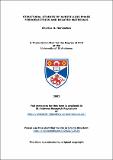Structural studies of Aurivillius phase ferroelectrics and related materials
Abstract
The research carried out for this thesis has concentrated on Aurivillius bismuth oxide materials and the closely related Sillen and Bipox bismuth oxyhalides. X-ray and neutron powder diffraction techniques have been used to characterise precisely their structure and revealed several important features.
The unexpected presence of a double phase transition scheme has been discovered for the Aurivillius phases Sr0.85Bi2.1Ta2O9 and SrBi4Ti4O15, both materials present the particularity of having an even number of perovskite layers n (n = 2 and n = 4 for Sr0.85Bi2.1Ta2O9 and SrBi4Ti4O15 respectively). The first transition from orthorhombic space group A21am to Amam, occurs at Tc (375°C and 550°C for Sr0.85Bi2.1Ta2O9 and SrBi4Ti4O15 respectively). The second transition from orthorhombic Amam to tetragonal I4/mmm, occurs at higher temperature (550°C and 650°C for Sr0.85Bi2.1Ta2O9 and SrBi4Ti4O15 respectively). These phase transitions have been understood in terms of specific octahedral tilt and displacive modes.
In contrast, the n = 2 phase SrBi2Nb2O9 and the n = 3 phase Bi4Ti3O12 are shown to undergo a single-step transition from orthorhombic space group A21am to tetragonal I4/mmm at Tc = 440°C for SrBi2Nb2O9, and from orthorhombic space group B2cb to tetragonal I4/mmm at Tc = 675°C for
Aurivillius phases has been demonstrated and thoroughly studied for the solid solutions Bi4-xSrxTi3-xNbxO12 and Bi4-xLaxTi3O12, and "size-matching" between the fluorite and the perovskite site has been found to be the key to understanding this disorder phenomenon. In the Sillen family, we extended the members of the Bi2MO4Cl group, where M = Lanthanide to the three following compounds: Bi2ErO4Cl, Bi2YbO4Cl, and Bi2LuO4Cl. We have demonstrated that in the Bi2MO4Cl group, the ionic radius of M must be greater than that of Sc3+ (r (Sc3+) = 0.87 Å for CN = 8). Another new compound with a novel ordering scheme for this family has been studied, viz. Bi5TeO8.5I2, crystallising in the orthorhombic space group Cmm2. Te4+ is shown to adopt only one of the three available M sites, thus inducing a polar structure. In the Bipox family, the crystal structures of two materials exhibiting ferroelectric properties, Bi4NbO8Cl and Bi4TaO8Cl have been determined to be orthorhombic, space group P21cn.
Type
Thesis, PhD Doctor of Philosophy
Collections
Items in the St Andrews Research Repository are protected by copyright, with all rights reserved, unless otherwise indicated.

